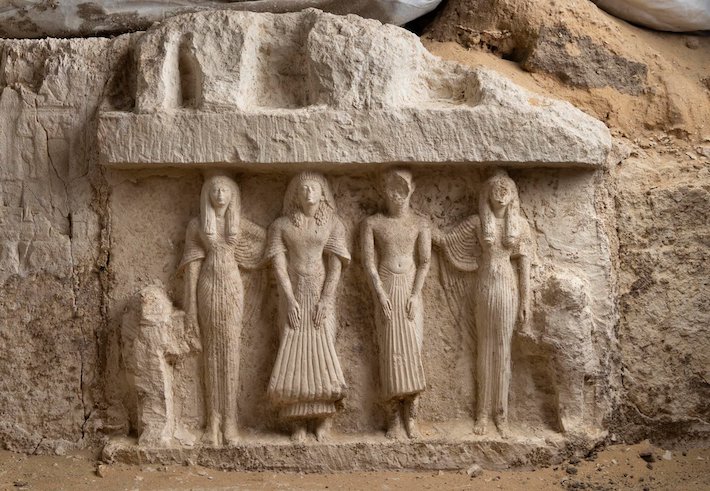 CAIRO, EGYPT—Ahram Online reports that the 3,000-year-old tomb of Panehsy, a steward of the Amun Temple in Karnak, and a collection of smaller tomb chapels have been discovered in the Saqqara necropolis by a team of researchers from Leiden’s National Museum of Antiquities and Turin’s Egyptian Museum. “The new discovery sheds new light on the development of Saqqara necropolis during the Ramesside period and introduces new individuals that were yet unknown in the historical sources,” explained Mostafa Waziri of the Supreme Council of Antiquities. The tomb’s temple features a gate entrance, an inner courtyard with columned porticoes, a shaft leading to underground burial chambers, and surviving mudbrick walls standing about five feet tall, he added. A carving showing Panehsy worshipping the cow goddess Hathor was also found, along with a sculpture of Panehsy and his wife Baia, who served as the singer of Amun, seated before an offering table opposite a bald man wearing a leopard skin around his shoulders. This man has been identified as the priest in charge of the couple’s mortuary cult. The smaller chapels found near Panehsy’s tomb were also well preserved and decorated with detailed reliefs and sculptures, concluded Lara Weiss of Leiden’s National Museum of Antiquities. To read about the enduring appeal of Amun in both Egypt and Nubia, go to "The Cult of Amun."
CAIRO, EGYPT—Ahram Online reports that the 3,000-year-old tomb of Panehsy, a steward of the Amun Temple in Karnak, and a collection of smaller tomb chapels have been discovered in the Saqqara necropolis by a team of researchers from Leiden’s National Museum of Antiquities and Turin’s Egyptian Museum. “The new discovery sheds new light on the development of Saqqara necropolis during the Ramesside period and introduces new individuals that were yet unknown in the historical sources,” explained Mostafa Waziri of the Supreme Council of Antiquities. The tomb’s temple features a gate entrance, an inner courtyard with columned porticoes, a shaft leading to underground burial chambers, and surviving mudbrick walls standing about five feet tall, he added. A carving showing Panehsy worshipping the cow goddess Hathor was also found, along with a sculpture of Panehsy and his wife Baia, who served as the singer of Amun, seated before an offering table opposite a bald man wearing a leopard skin around his shoulders. This man has been identified as the priest in charge of the couple’s mortuary cult. The smaller chapels found near Panehsy’s tomb were also well preserved and decorated with detailed reliefs and sculptures, concluded Lara Weiss of Leiden’s National Museum of Antiquities. To read about the enduring appeal of Amun in both Egypt and Nubia, go to "The Cult of Amun."
Tomb of Amun Temple Steward Discovered in Saqqara
